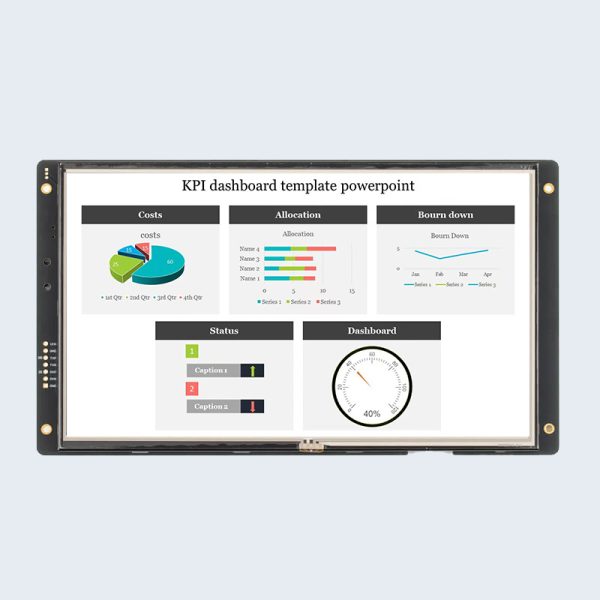汽车行业正在不断发展,而车辆仪表系统中最显著的进步之一便是将串口屏(薄膜晶体管)显示屏应用于汽车仪表盘。本文将深入探讨串口屏在现代汽车仪表盘中的适用性,分析其优势、技术规格以及日益普及的原因

串口屏简介
什么是串口屏?
串口屏(薄膜晶体管)是一种基于薄膜晶体管技术的液晶显示(LCD)技术,通过薄膜晶体管技术提升显示质量。在汽车仪表盘中,串口屏用于呈现速度、导航、发动机诊断等多种信息。与传统显示屏相比,串口屏技术具备更高的色彩准确性和响应速度。
仪表盘技术的发展
多年来,汽车仪表盘已从模拟仪表逐渐过渡到数字显示屏。转向串口屏标志着这一演进的最新阶段,其驱动力在于对更先进、可定制化界面的需求。这一变革提升了用户体验和功能性,为车辆仪表系统树立了新标准。
串口屏在汽车仪表盘中的优势
视觉清晰度提升
串口屏以高分辨率和生动的色彩还原著称。这种清晰度对驾驶员在驾驶过程中快速准确地解读关键信息至关重要。例如,串口屏屏幕提供的鲜明对比度和宽广视角确保数据在不同角度和光线条件下均清晰可读。
灵活性与定制化
串口屏的一大突出特点是其灵活性。这些屏幕可定制显示多种信息布局。例如,驾驶员可根据个人偏好或驾驶环境选择不同主题和配置。这种定制化设计通过以驾驶员所需格式呈现相关信息,显著提升驾驶体验。
能效优势
现代串口屏在设计时充分考虑了能效需求。与传统LCD屏幕相比,串口屏技术功耗更低,有助于提升车辆整体能效。这一特性在电动及混合动力车辆中尤为重要,因其对优化能源利用有严格要求。
串口屏的技术规格
分辨率和亮度
汽车串口屏提供多种分辨率,通常范围从800×480像素到1920×1080像素。更高分辨率可呈现更细致的细节和更清晰的图像,这对显示复杂的仪表盘信息至关重要。此外,亮度可调节以确保在不同光线条件下(从直射阳光到低光环境)的可读性。
响应时间和刷新率
串口屏的响应时间指像素从一种颜色切换到另一种颜色的速度,对确保平滑过渡和动画效果至关重要。更低的响应时间可提升性能,尤其在显示实时导航更新等动态内容时。同样,高刷新率能使显示屏快速更新,从而提升整体用户体验。
耐用性和使用寿命
串口屏专为应对汽车环境的严苛条件而设计。其结构可抵御振动、温度波动及其他车辆常见的恶劣环境。这种耐用性确保显示屏在整个使用寿命期间保持性能和外观,为车辆提供可靠服务。
挑战与考量
成本影响
尽管串口屏具备诸多优势,但与传统模拟仪表或基本LCD屏幕相比,其成本更高。这一成本因素可能成为制造商和消费者的考量因素。然而,增强的功能性和用户体验通常能抵消初始投资。
与车辆系统集成
将串口屏与现有车辆系统集成可能面临挑战。确保与各类传感器、控制器及软件的兼容性对实现无缝运行至关重要。制造商必须精心设计并测试这些集成方案,以避免问题并确保最佳性能。
用户界面设计
串口屏的有效性也取决于其用户界面设计。设计良好的界面可显著提升易用性,而设计不良的界面则可能导致驾驶员分心。制造商需投资于以用户为中心的设计,以创建直观且易于操作的界面。
串口屏在汽车仪表盘中的未来
新兴趋势
汽车行业正见证多个可能影响串口屏未来发展的趋势。例如,增强现实(AR)技术在仪表盘中的集成正日益普及。AR技术可在真实世界视图上叠加额外信息,为驾驶员提供增强的态势感知能力和更具互动性的体验。
显示技术的发展
显示技术领域的持续创新,如有机发光二极管(OLED)和微发光二极管(microLED),可能对串口屏的未来产生深远影响。这些技术在色彩准确性、对比度和灵活性方面具有显著优势。随着这些技术的不断发展,串口屏可能演变或与新科技相结合,以满足未来车辆的需求。
结论
综上所述,串口屏已证明是现代汽车仪表盘的合适且优势明显的选项。其增强的视觉清晰度、灵活性和能效使其成为以清晰可定制格式向驾驶员提供关键信息的理想选择。尽管面临成本和集成等挑战,串口屏技术带来的优势对汽车仪表盘的进步具有重要意义。随着行业持续创新,串口屏有望在塑造未来车辆仪表盘中发挥核心作用。